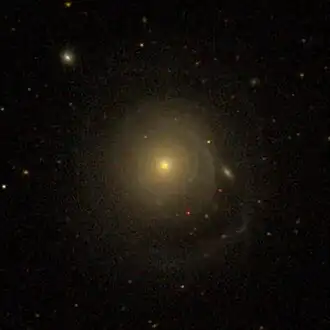NGC 3106
| NGC 3106 | |
|---|---|
 NGC 3106 imaged by Sloan Digital Sky Survey | |
| Observation data (J2000 epoch) | |
| Constellation | Leo Minor |
| Right ascension | 10h 04m 05.2636s[1] |
| Declination | +31° 11′ 07.756″[1] |
| Redshift | 0.020654 ± 0.000007 [1] |
| Heliocentric radial velocity | 6,192 ± 2 km/s[1] |
| Distance | 293 ± 21 Mly (89.9 ± 6.3 Mpc)[1] |
| Apparent magnitude (V) | 12.3[2] |
| Characteristics | |
| Type | S0 [1] |
| Size | ~103,000 ly (31.7 kpc) (estimated)[1] |
| Apparent size (V) | 1.43′ × 1.12′[1] |
| Other designations | |
| IRAS F10012+3125, UGC 5419, MCG +05-24-009, PGC 29196, CGCG 153-013[1] | |
NGC 3106 is a lenticular galaxy in the constellation Leo Minor. The galaxy lies about 290 million light years away from Earth, which means, given its apparent dimensions, that NGC 3106 is approximately 100,000 light years across.[1] It was discovered by William Herschel on March 13, 1785.[3]
Characteristics
The galaxy is characterised as a lenticular galaxy, having a disk and a bulge. Almost 95% of the stars in the bulge are old, created more than 6 billion years ago, while the stars in the disk are younger, as 77% are older than 6 billion years.[4] Its nucleus is active and based on its emission is characterised as a LINER.[5] There is also some star formation taking place at the central region of the galaxy disk, but not in the bulge.[4] The star formation at the centre of the galaxy could be the result of tidal interaction.[6]
The outer regions of the galaxy feature faint structures that resemble spiral arms. Although otherwise faint, they are the source of more than half of the H-alpha emission of the galaxy.[5] HII regions have been detected in these spiral features, indicating they are locations of active star formation. The star formation rate is estimated to be 0.1–0.3 M☉ per year.[5] The innermost star formation ring has a radius of 20 arcseconds while the galaxy has a series of rings.[7]
Supernovae
Three supernovae have been discovered in NGC 3106:
- SN 1983J (type unknown, mag. 16.0) was discovered by Russian astronomer Natalya Metlova on 8 April 1983.[8][9][10]
- SN 2009gt (type unknown, mag. 16.1) was discovered by the Catalina Real-time Transient Survey on 25 June 2009.[11][12]
- SN 2021aewn (Type II, mag. 18.658) was discovered by ATLAS on 18 November 2021.[13]
Nearby galaxies
NGC 3106 is a field galaxy, meaning it doesn't belong in a galaxy group. Seven dwarf companion galaxies have been found in its vicinity.[5] Other nearby galaxies include NGC 3116 and UGC 5481.[14]
References
- ^ a b c d e f g h i j "Results for object NGC 3106". NASA/IPAC Extragalactic Database. NASA and Caltech. Retrieved 17 February 2025.
- ^ "Revised NGC Data for NGC 3106". spider.seds.org. Retrieved 30 March 2024.
- ^ Seligman, Courtney. "NGC 3106 (= PGC 29196)". Celestial Atlas. Retrieved 19 November 2018.
- ^ a b Méndez-Abreu, J; Sánchez, S F; de Lorenzo-Cáceres, A (11 April 2019). "Spectro-photometric decomposition of galaxy structural components". Monthly Notices of the Royal Astronomical Society. 484 (3): 4298–4314. arXiv:1901.08075. doi:10.1093/mnras/stz276.
- ^ a b c d Gomes, J. M.; Papaderos, P.; Vílchez, J. M.; Kehrig, C.; Iglesias-Páramo, J.; Breda, I.; Lehnert, M. D.; Sánchez, S. F.; Ziegler, B.; dos Reis, S. N.; Bland-Hawthorn, J.; Galbany, L.; Bomans, D. J.; Rosales-Ortega, F. F.; Walcher, C. J.; García-Benito, R.; Márquez, I.; del Olmo, A.; Mollá, M.; Marino, R. A.; Catalán-Torrecilla, C.; González Delgado, R. M.; López-Sánchez, á. R. (January 2016). "Spiral-like star-forming patterns in CALIFA early-type galaxies". Astronomy & Astrophysics. 585: A92. arXiv:1511.00744. Bibcode:2016A&A...585A..92G. doi:10.1051/0004-6361/201525974.
- ^ Lin, Lin; Li, Cheng; He, Yanqin; Xiao, Ting; Wang, Enci (1 April 2017). "Bar-induced Central Star Formation as Revealed by Integral Field Spectroscopy from CALIFA". The Astrophysical Journal. 838 (2): 105. arXiv:1609.05287. Bibcode:2017ApJ...838..105L. doi:10.3847/1538-4357/aa657a.
- ^ Sil’chenko, Olga K.; Moiseev, Alexei V.; Egorov, Oleg V. (1 September 2019). "The Gas Kinematics, Excitation, and Chemistry, in Connection with Star Formation, in Lenticular Galaxies". The Astrophysical Journal Supplement Series. 244 (1): 6. arXiv:1907.07261. Bibcode:2019ApJS..244....6S. doi:10.3847/1538-4365/ab3415.
- ^ Barbon, R.; Cappellaro, E.; Turatto, M. (1 December 1989). "The Asiago supernova catalogue". Astronomy and Astrophysics Supplement Series. 81: 421–443. Bibcode:1989A&AS...81..421B. ISSN 0365-0138.
- ^ Aksenov, E. P.; Terebizh, Yu. V. (24 May 1983). "Supernova in NGC 3106". International Astronomical Union Circular (3815): 2. Bibcode:1983IAUC.3815....2A.
- ^ "SN 1983J". Transient Name Server. IAU. Retrieved 4 August 2025.
- ^ Drake, A. J.; et al. (27 June 2009). "Supernova 2009gt in NGC 3106". Central Bureau Electronic Telegrams (1862): 1. Bibcode:2009CBET.1862....1D.
- ^ "SN 2009gt". Transient Name Server. IAU. Retrieved 4 August 2025.
- ^ "SN 2021aewn". Transient Name Server. IAU. Retrieved 4 August 2025.
- ^ Crook, Aidan C.; Huchra, John P.; Martimbeau, Nathalie; Masters, Karen L.; Jarrett, Tom; Macri, Lucas M. (February 2007). "Groups of Galaxies in the Two Micron All Sky Redshift Survey". The Astrophysical Journal. 655 (2): 790–813. arXiv:astro-ph/0610732. Bibcode:2007ApJ...655..790C. doi:10.1086/510201.
External links
- NGC 3106 on WikiSky: DSS2, SDSS, GALEX, IRAS, Hydrogen α, X-Ray, Astrophoto, Sky Map, Articles and images